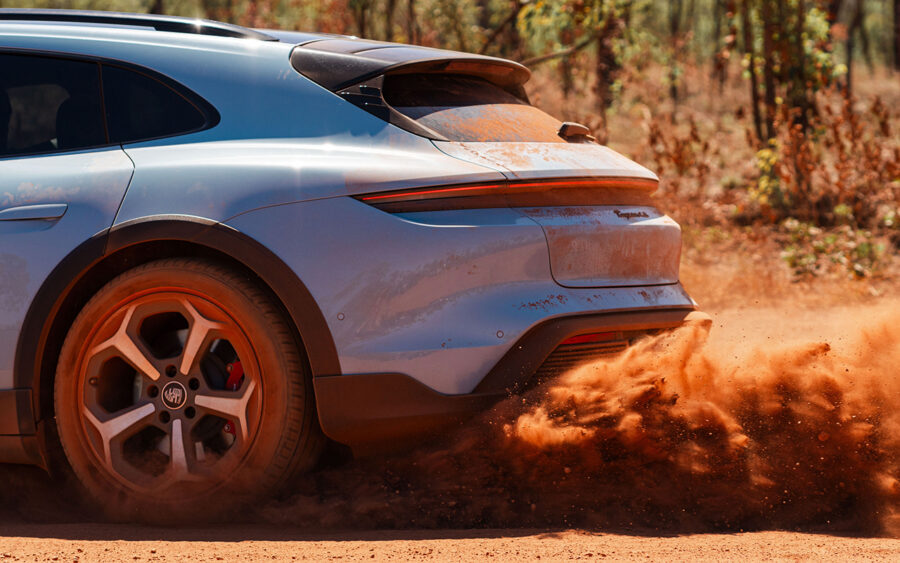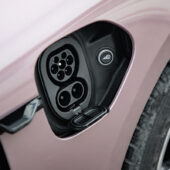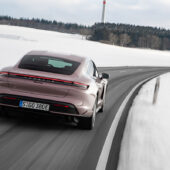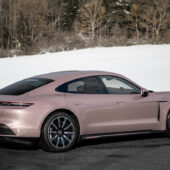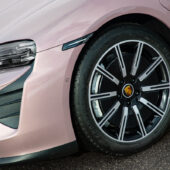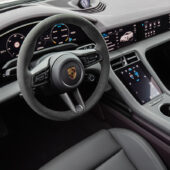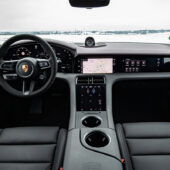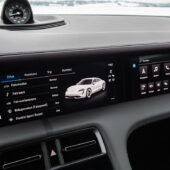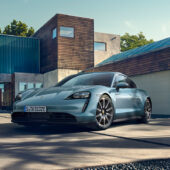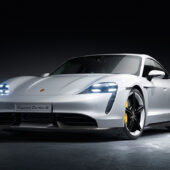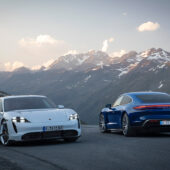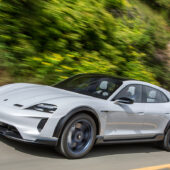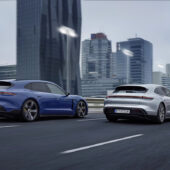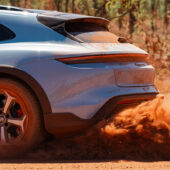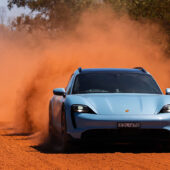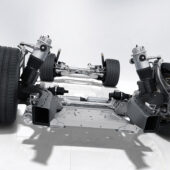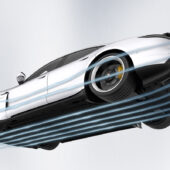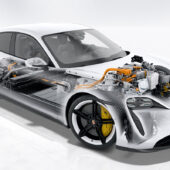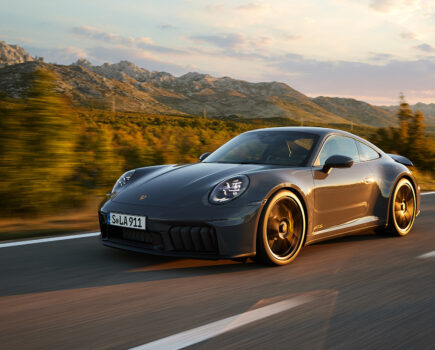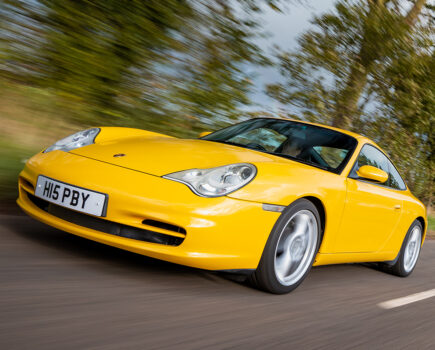The Porsche Taycan combines real practicality with huge performance courtesy of potent pure-electric power. Here’s the full story
Words: Jon Burgess Images: Porsche
There had been four-door Porsches throughout the firm’s history: the Troutman and Barnes 911, the firm’s own Harm Lagaay-styled front-engined V8 989, and more recently, the Panamera, from 2009. The Mission E concept of 2015 was different, however; it previewed Porsche’s first fully electric platform, ‘J1’, co-developed with Audi for its e-tron GT.
The platform allowed for up to two rows of batteries, together with the control unit, cooling, connectors and rear footwells (aka ‘foot garages), to power as many as two permanently excited synchronous motors depending on specification; styling the Mission E fell to Porsche chief designer, Michael Mauer.
Taycan’s name, chosen in 2017, derived from a loose Turkic translation of ‘soul of a young, fast horse’, at once referring to its nascent EV schedule and the prancing horse on the Porsche crest, chosen by Porsche’s senior So as Porsche’s febrile engineering career began, so too did that of the Taycan.
A year later, another concept car was ready: the Mission E Cross Turismo, previewing a production variant that would launch in 2021. With its five-door, hatchback body, raised ride height and all-terrain tyres, it added to Porsche’s range of shooting breaks, the Panamera Sport Turismo having been added to the Panamera line-up a year earlier.
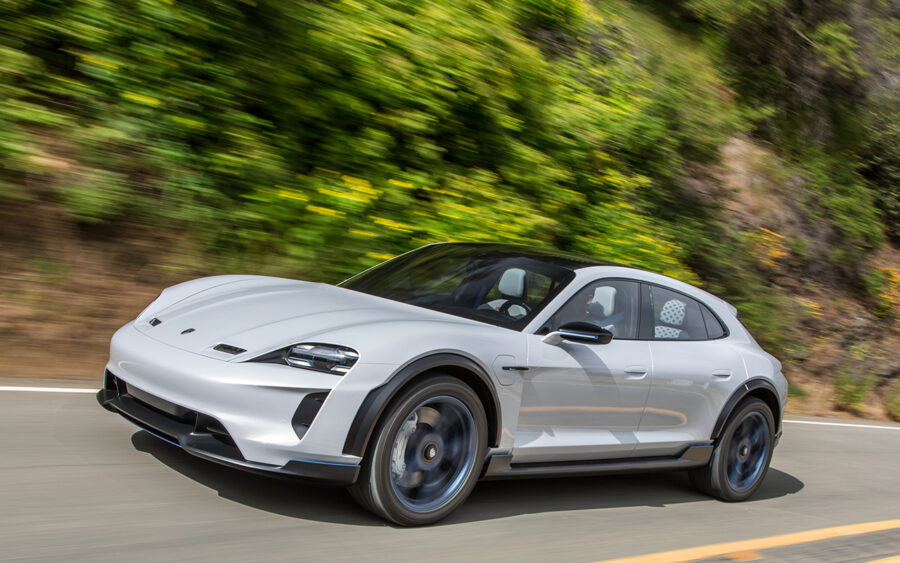
Porsche Mission E Cross Turismo concept
Of course, three decades prior, Porsche’s five-door 928 ‘H50’ study showed how things could have gone, but at least it established a precedent, not to mention the 928 and 924 Kombis (built in 1978 and 1981 respectively) by Gunter Artz.
Much of Mauer’s (‘frunk and trunk’) saloon Mission E translated into Porsche Exterior Designer Mitja Borkert’s production Taycan, known within Porsche as ‘9J1’, though the latter car did without Mission E’s suicide/coach doors and floating B-pillar, though Taycan Turbo S models received very similar looking 21-inch alloys as standard.
Launched simultaneously across three continents in September 2019 (Berlin, Germany; Fuzhou, China, and Toronto, Canada), only the two top Taycan models were available at launch: Turbo and Turbo S, Porsche continuing with ‘Turbo’ as the name for its flagship Taycans despite an obviously missing means of forced induction, a point not lost on marque faithful, who felt that the name should only appear on liquid-fuelled Porsches.
Turbo and Turbo S Taycans were (and remain) all-wheel-drive, one-motor-per-axle cars, with two charging ports on either side of the A pillar: both left and right hand ports permitted AC charging.
Different regions prioritised different chargers. Europe and US, using the Combined Charging System, AC sources can be connected to either side and DC sources can only be connected to the passenger’s side. On Chinese and Japanese market Taycans, specified for GB/T formerly, and CHAdeMO, latterly, the driver’s side contained the AC charging port and the passenger’s side housed itsDC equivalent.
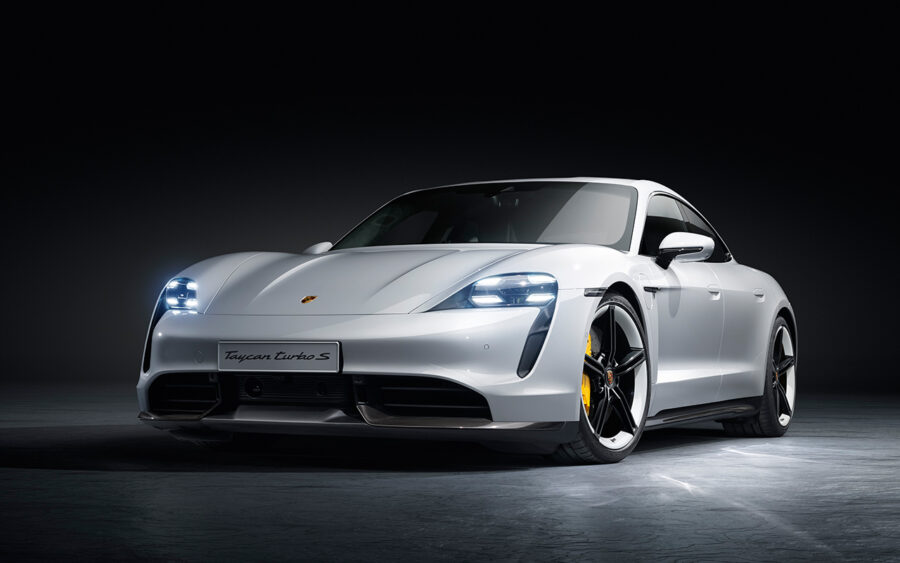
Porsche Taycan Turbo S
Turbo S models had Power Charge Port Covers as standard (from 2020) – by pressing on a fin fitted next to the port, it would open electrically. Turbos (and other, later variants) could specify the motored covers as an option, along with an optional so-called icebreaker to warm the port edges in winter to prevent freezing.
Powerful though the Turbo and Turbo S were, with 617bhp each, the larger inverter on the Turbo S allowed for a greater overboost power peak when launch control was activated. For 2.5 seconds, 671bhp (Turbo) or 751bhp (Turbo S) was possible.
First to arrive, in October of 2019, was the mid-range 4S, with continuous power of 429–483bhp depending on the battery fitted; the reduction in power was achieved by fitting a smaller rear motor, though the 4S remained all-wheel-drive; its front motor was of the same output as the Turbo and Turbo S.
Other Turbo and Turbo S features would filter down the Taycan range as it broadened between 2019 and 2021, such as their standard fit, two-deck 93.4kWh battery, known as Performance Battery Plus.
First offered as an option on the mid-range 4S, it would also be made available on the rear-wheel-drive base Taycan, debuting first in China in July 2020; by January the following year, European and US catalogues also had the Taycan added.
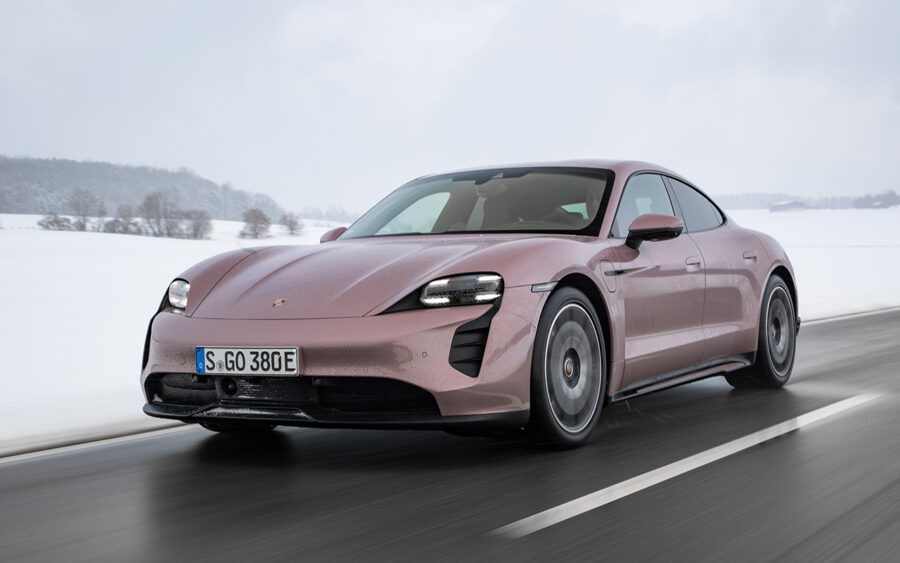
The base-model Porsche Taycan
Preferred by some critics as the purest, rearward biased driving experience, the base Taycan – like the 4S – was fitted with a 79.2 kWh Performance Battery as standard, managing 322bhp in continuous performance and 402bhp peak on overboost. With Performance Battery Plus, 375bhp and 469bhp was available, respectively.
Buyers got their first glimpse of the productionised Mission E Cross Turismo – now known as the Taycan Cross Turismo – in March of 2021. Sales began worldwide across the summer building on a successful full year’s production of the saloon (all variants) of more than 20,000 units in 2020.
While reasonably roomy as a saloon, the J1 platform was more than capable of taking different bodies; with the hatchback estate configuration of the Cross Turismo, a large hatchback configured and sold as an estate, space went up from 82 litres/405 litres (frunk/boot, Taycan saloon) to 82 litres/446 litres (frunk and boot, seats up, Cross Turismo). Folded down, 1212 litres was available.
Boasting less off-road capability than a Cayenne, the Cross Turismo nevertheless had 20mm more ride height than a standard Taycan, an optional Off-Road Package boosted that by a further 10mm, all the more to work the three-chamber air ride, controlled by Porsche Active Suspension Management.
Further underlining its rough-road-but-not-pay-and-play intentions, a special sixth Cross Turismo driving mode was added – for gravel, fine tuning the accelerator input, stability control and chassis/suspension settings. Other driving modes – Sport, Sport Plus, Normal, Range, and Individual – remained as per the Taycan saloon.
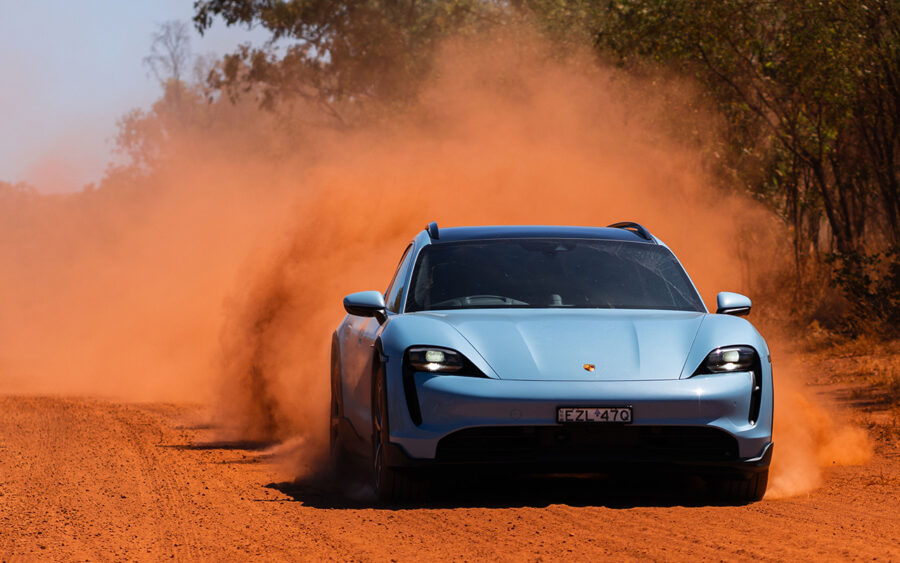
Porsche Taycan 4S Cross Turismo on a 5,000km trip across Australia – from Darwin to Bondi Beach – in 2023
Cross Turismo powertrain specifications were broadly similar to that of equivalent Taycans, but, owing to its more ambitious remit, no Cross Turismo was made available with rear-wheel drive.
All Cross Turismos were fitted from launch with the larger Performance Battery Plus (93.4 kWh), albeit with slightly different designations. Cross Turismo’s range ran 4-4S-Turbo-Turbo S, with no 590bhp GTS large battery equivalent positioned as a bridge between the Taycan 4S and Turbo saloon.
Last to arrive in the Taycan range was the Sport Turismo, in effect a Cross Turismo with the ride height of the Taycan saloon, a rear-wheel-drive base model option and the gravel driving and suspension modes removed. While at time of writing rumours persist of coupe and convertible Taycan variants, the Sport Turismo has been the last official addition to the Taycan range, debuting in February 2022.
As befitted its ‘practical all-rounder’ status (Porsche’s words), the mid-range GTS was the first Cross Turismo to appear, with a range structure otherwise identical to the Taycan saloon, with Sport Turismo (rear-wheel-drive) and Sport Turismo 4S models at the bottom of the tree (available with 79.2 kWh Performance batteries as standard, and 93.4 kWh Performance Battery Plus cells as options), with three Performance-Battery-Plus-as-standard models going upward, through GTS, Turbo and Turbo S.
From the outset, Porsche intended for the Taycan and variants to support 800V DC charging, enabling the right fast 350kW charger to boost a flat single-deck Performance Battery unit from 5% to 80% in under half-an-hour, depending on the charging network and weather conditions; 400 such sites will be built in partnership with power supplier Ionity, with which Porsche (and Audi, BMW, Daimler, Ford and Hyundai) have also signed. Electrify America, a VW Group initiative, plans to build 300 sites across the USA with similar power.

An on-board step-up transformer also makes the Taycan backwards compatible with older 400V chargers; Mode 3 adaptors allow Taycan owners to plug in at public AC chargers, and supplied adaptors have opened up some of Tesla’s Supercharger and Destination network chargers in the United States, owing to an initiative from the Biden Administration.
Free Destination Chargers have also been set up with different providers across 75 countries, with more than 2000 currently in use in Europe, and around 300 in the United States. Porsche’s Charging Service opens up another 135,000 points around the world, with plans to also equip Porsche dealers with 800-volt charging sites.
While many viewed Taycan as the beginning for Porsche, it really marked a continuation of a considerable EV legacy. Its next battery car venture with Audi, the modular Premium Platform Electric, can span several different configurations of car, encompassing SUVs, saloons and people carriers.
Though the 911 represents Porsche’s continued sports car heritage, the future of the firm, first assured by the Boxster (and later by the Cayenne SUV) is part off-roader, and part-electric, as befits aggressive plans to offer half its range with battery power (either as EVs or hybrids) by 2025. Porsche wants 80 per cent of its cars electrified five years after that.
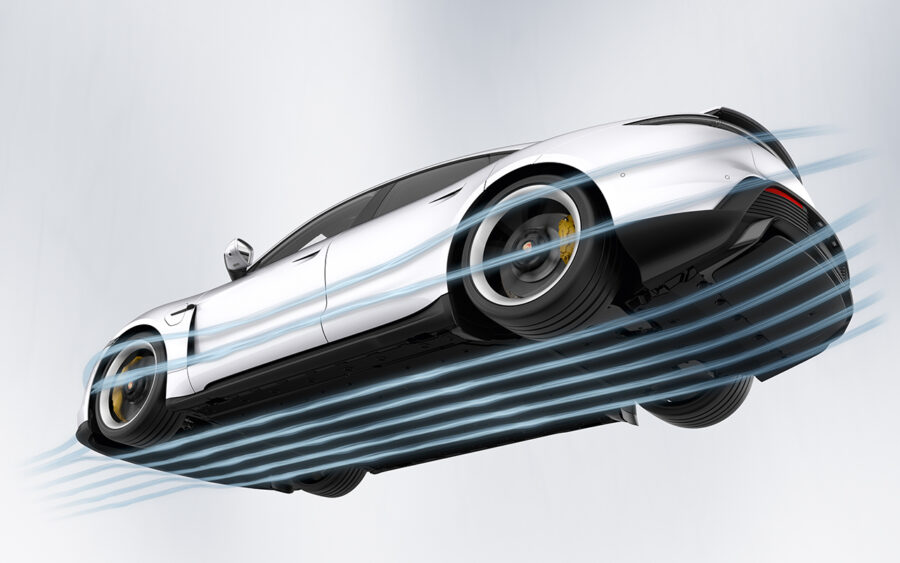
Porsche Taycan timeline
2015
Porsche Mission E (Taycan concept) debuts at the Frankfurt Motor Show. New ‘J1’ platform for battery power. Suicide doors, twin motors, one per axle, 590bhp, 311-mile quoted range.
2016
Porsche shows a recreation of the Lohner-Porsche ‘Semper Vivus’ at the Geneva Motor Show.
2017
First development Taycans spotted testing.
2018
Porsche Mission E Cross Turismo (Cross Turismo concept) revealed at Frankfurt. Raised ride height, five-door estate body, all-terrain tyres. Spy shots of development Taycans (then un-named) prompt a public video with a camouflaged prototype.
Taycan ‘flexi-line’, with autonomous guided vehicle (AGV) carts for bodies commences construction at Stuttgart-Zuffenhausen.
2019
Production Taycan (9J1) premieres in September.
Ordered cars begin production that month. Cars go on sale as four-door saloons, with two variant range, both all-wheel-drive, one-motor-per-axle cars: range consists initially of the top-tier Taycan Turbo and Turbo S.
Third variant, mid-range 4S, joins Taycan range in October.
Taycan, with racing driver Lars Kern, laps the Nürburgring Nordschleife in 7 minutes and 42.34 seconds; between the 911 997 GT3 3.8 and the Cayman 981 GT4 on a leaderboard.
Aboard the flight deck of the USS Hornet, a Taycan Turbo S performs a 0-90mph-0 acceleration-deceleration run.
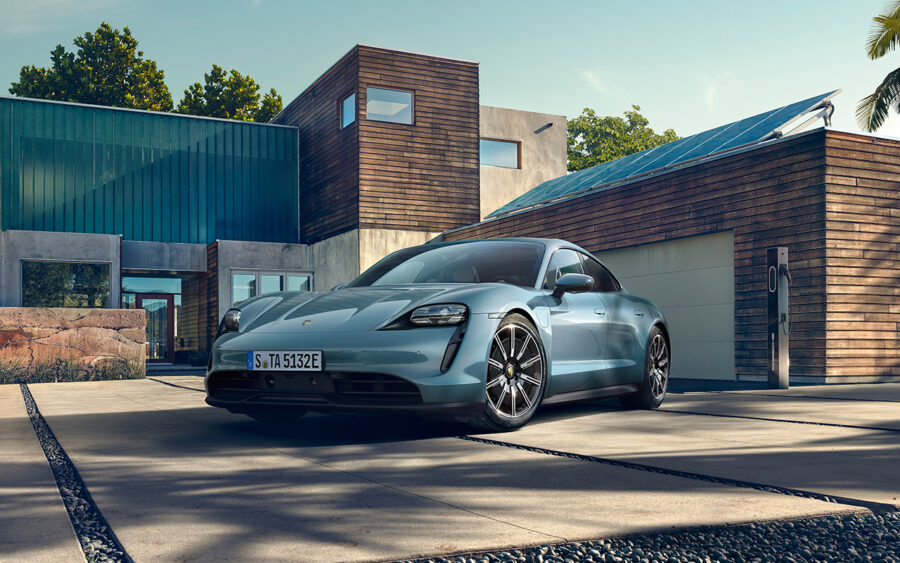
Porsche Taycan 4S
2020
Rear-wheel-drive, single rear motor Taycan launched for Chinese market in July.
Optional 22kW AC charger offered to speed up charging at home.
More than 20,000 units sold in first full year of production.
2021
US and European market base rear-wheel-drive Taycan launched in January.
Rear-wheel-drive Taycan GTS variant (between 4S and Turbo) announced November alongside road-biased, five-door estate Sport Turismo, sharing Taycan saloon ride height.
Two-deck, 93.4kWh Performance Battery Plus option offered on Taycan and Taycan 4S.
Five-door, crossover Cross Turismo announced in March (available as 4, 4S, Turbo and Turbo S); deliveries begin summer 2021.
Optional Plug & Charge feature rolled out to all models; automatic charging and billing as soon as the car is connected to a compatible charger.
2022
Sport Turismo now on sale, in base 4, mid-range 4S, then high-end Turbo and Turbo S variants.
Taycan chosen as the Formula E Championship safety car, replacing the Mini Pacesetter and BMW i8 Roadster.
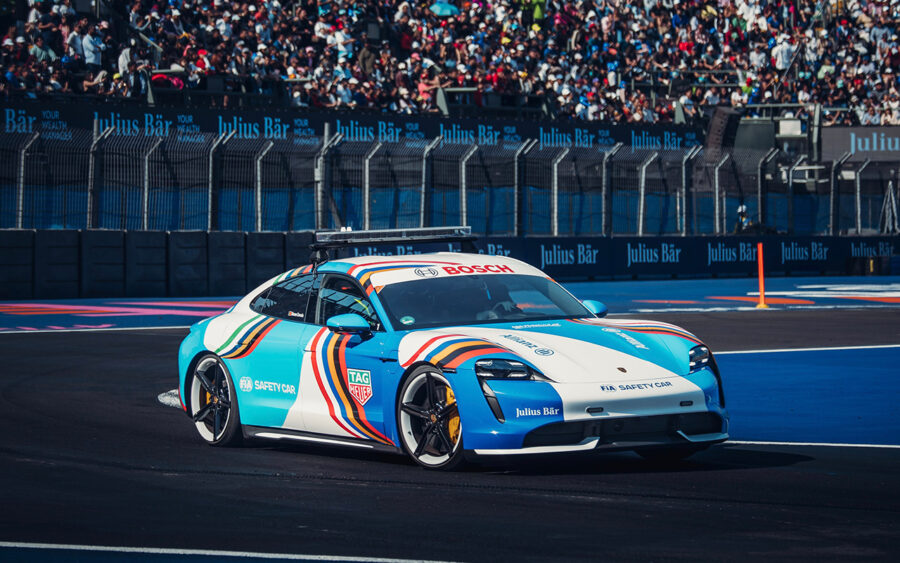
Porsche Taycan Turbo S Formula E Safety Car
2023
Software updates boost range of Taycan and Taycan 4S with Performance Battery Plus option, as well as Turbo and Turbo S; all Taycan models can also receive the ‘Comfort Access’ upgrade (opening doors and ‘frunk’/boot by foot movement) by request.
Porsche announces ‘electric roadmap’ with future iterations of 718, Macan, Cayenne and new range-topping, hitherto-unseen ‘K1’ SUV to be fully electric.
Porsche confirms a new platform – Premium Platform Electric (PPE) – co-developed with Audi, will underpin its new electric range of models, starting with the new Macan.
2025
Porsche projection – half of its cars to be electrified, either as battery electric or plug-in hybrid models.
2030
Porsche projection – 80 per cent of new car deliveries to be fully electric.

